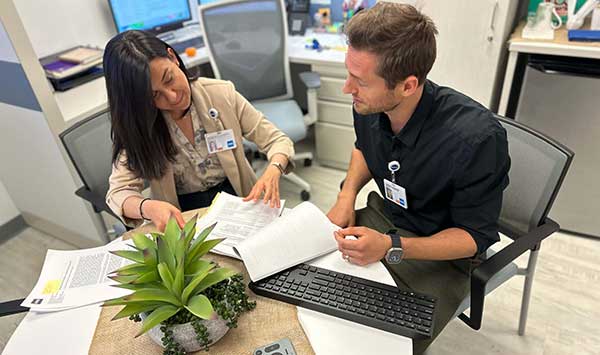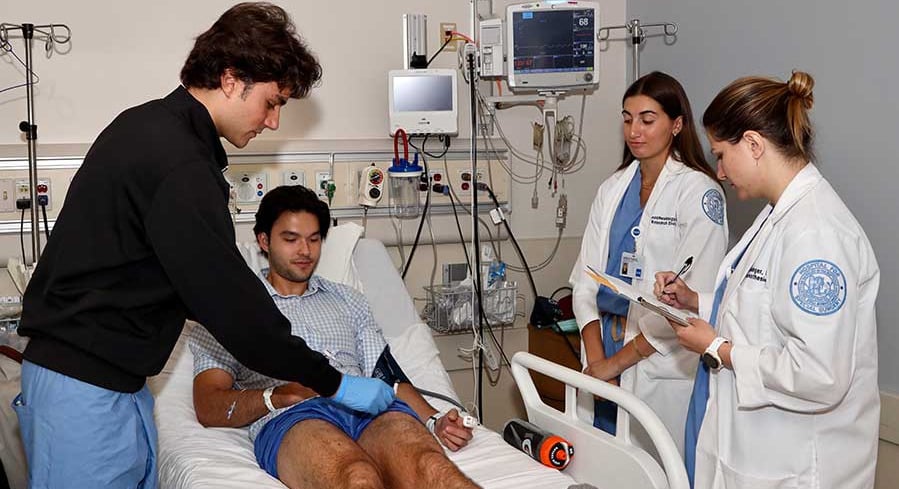Primary Prevention
- Prevent need for surgery (e.g., spine surgery for those unlikely to benefit)
- Prevent pain condition (e.g., CRPS)
Seeking solutions for pain prevention.
The societal impact of chronic pain is significant, and the effects on those who personally experience chronic pain can be devastating. Pain conditions, like low back pain and headache disorders, have been among the leading causes of disability for decades, according to the Global Burden of Disease Study. The overall annual cost of chronic pain in the US is estimated at $635 billion.

1 in 5 adults in the US (or 50+M people) live with chronic pain that affects their daily life

Neck and back pain comprised the highest amount of US healthcare costs in 2016

Missing work due to low back pain accounts for 40% of workplace absences
The Pain Prevention Research Center at HSS is unique in its focus and commitment to studying the prevention of pain and associated deleterious outcomes. As the #1 ranked hospital for Orthopedics by US News and World Report for 14 years in a row, HSS has an unmatched level of expertise in both treating and preventing musculoskeletal pain. In 2023, our surgical teams performed over 41,500 orthopedic procedures and HSS clinicians provided over 500,000 nonsurgical consultations for musculoskeletal conditions. The large volume of patients seen at HSS combined with our long-standing commitment to clinical and basic science research aligns perfectly with the mission of the Pain Prevention Research Center to seek solutions for pain prevention.
There are limited safe and effective treatments for chronic pain. Most existing treatments are ineffective or only modestly effective for many people. Efforts to develop novel pain treatments have been largely unsuccessful. Given the high prevalence and complexity of chronic pain, as well as its significant personal and societal cost, a pivot in our approach to mitigating pain is critical. The most promising approach may be in its prevention.
We can define pain prevention as three different types: primary prevention, secondary prevention, or tertiary prevention. In the context of pain prevention research, we can define primary prevention as preventing a painful stimulus or preventing a pain condition before it develops, secondary prevention as identifying and treating pain early following a painful stimulus, and tertiary prevention as preventing the persistence or exacerbation of pain.
The overarching goal of the PPRC is to build a collaborative, dynamic, accessible and inclusive research environment that spans acute and chronic pain, provides supportive and unique training opportunities, and produces clinically meaningful and informative findings that improve patient outcomes.
To that end, the specific goals of the center are to:
The pain continuum spans several phases including acute, sub-acute, and chronic pain. Projects led by the PPRC aim to provide clinically impactful results that improve the pain management and clinical outcomes of patients in both the acute perioperative and chronic pain settings:
Please navigate to the Highlighted Work tab to learn more about the PPRC's research.
The Pain Prevention Research Center at HSS brings together a team of dedicated researchers, clinical scientists, and administrators. The vision of the team is to support innovative, high-quality research investigations focused on primary, secondary, and tertiary pain prevention through study design, research conduct, and biostatistical support from content experts.
If you are interested in learning more about the Prevention Research Center, email us at PPRC@hss.edu



NIH-funded Translational Pain Research Training Program (Pain-Train): Learn more about Pain-Train, a multidisciplinary, translational pain research curriculum to support trainees in orthopedics and engineering to incorporate pain research methodology into their research.
Foundation for Anesthesia Education and Research (FAER) Medical Student Anesthesia Research Fellowship (MSARF) summer program: As a host site for the FAER MSARF summer program, HSS welcomes medical students with interest in conducting anesthesiology or pain research. In this program, fellows have the opportunity to lead a research project with mentorship from an experienced investigator, observe clinical researchers and clinicians, and present findings at the American Society of Anesthesiologists' (ASA) annual meeting.
HSS Macaulay Scholars Summer Research Program: Through this program, the PPRC provides mentorship and clinical research experience to a Macaulay Honors College undergraduate student. Clinical research experiences may include shadowing, extracting data from the electronic medical record, assisting with systematic reviews, and writing and presenting scientific work.
The PPRC provides research opportunities to trainees, including volunteers, interns, and fellows, at various stages of their academic and professional careers. For more information about available opportunities, please reach out to PPRC@hss.edu.
Chan W, Rim F, Liu S, Jules-Elysee K, Liu J, Memtsoudis S, Sideris A. Inpatient dronabinol utilization: an institutional retrospective study to determine prevalence and indications for clinical application. Br J Anaesth. 2024 Apr 30. doi: 10.1016/j.bja.2024.03.026. PMID: 38693005.
Langford DJ, Mark RP, France FO, Nishtar M, Park M, Sharma S, Shklyar IC, Schnitzer TJ, Conaghan PG, Amtmann D, Reeve BB, Turk DC, Dworkin RH, Gewandter JS. Use of patient-reported global assessment measures in clinical trials of chronic pain treatments: ACTTION systematic review and considerations. PAIN. 2024, In press. doi: 10.1097/j.pain.0000000000003270. PMID: 38743561.
Sideris A, Doan LV. An overview of cannabidiol. Anesth Analg. 2024 Jan 1; 138(1): 54-68. doi: 10.1213/ANE.0000000000006584. PMID: 38108806.
Sideris A, Lauzadis J, Kaczocha M. The basic science of cannabinoids. Anesth Analg. 2024 Jan 1; 138(1): 42-53. doi: 10.1213/ANE.0000000000006472. PMID: 38100799.
Rim F, Liu SS, Kelly M, Kim D, Sideris A, Langford DJ. Preoperative pain screening and optimisation by a perioperative pain service to support complex surgical patients: no patient left behind. British Journal of Anaesthesia. 2024 Feb; 132(2): 437-439. doi: 10.1016/j.bja.2023.11.024. PMID: 29049115
Zhong H, Poeran J, Cozowicz C, Athanassoglou V, Illescas A, Memtsoudis SG, Liu J. Does the impact of peripheral nerve blocks vary by age and comorbidity subgroups? A nationwide population-based study. Reg Anesth Pain Med. 2023 Jul 5; doi: 10.1136/rapm-2022-104150. PMID: 37407280.
Wu CL, Cho B, Gabriel R, Hurley R, Liu J, Mariano ER, Mathur V, Memtsoudis SG, Grant MC. Addition of dexamethasone to prolong peripheral nerve blocks: a ChatGPT-created narrative review. Reg Anesth Pain Med. 2023 Jun 9:rapm-2023-104646. doi: 10.1136/rapm-2023-104646. Epub ahead of print. PMID: 37295794.
Langford DJ, Baron R, Edwards RR, Gewandter JS, Gilron I, Griffin R, Kamerman PR, Katz NP, McDermott MP, Rice ASC, Turk DC, Vollert J, Dworkin RH. What should be the entry pain intensity criteria for chronic pain clinical trials? An IMMPACT update. Pain. 2023 Jun 7. doi: 10.1097/j.pain.0000000000002930. Epub ahead of print. PMID: 37288944.
Memtsoudis SG, Zhong H, Liu J, Poeran J, Cozowicz C, Sites B. Persistent opioid use after gender affirmation surgery. Br J Anaesth. 2023 Jan; 130(1): e1-e4. doi: 10.1016/j.bja.2022.09.024. PMID: 36376101.
Langford DJ, Lou R, Sheen S, Amtmann D, Colloca L, Edwards RR, Farrar JT, Katz NP, McDermott MP, Reeve BB, Wasan AD, Turk DC, Dworkin RH, Gewandter JS. Expectations for improvement; A neglected but potentially important covariate or moderator for chronic pain trials. J Pain. 2023 Apr; 24(4): 575-581. doi: 10.1016/j.jpain.2022.12.011. PMID: 36577461.
Holzer KJ, Veasley C, Kerns RD, Edwards RR, Gewandter JS, Langford DJ, Yaeger LH, McNicol E, Ferguson M, Turk DC, Dworkin RH, Haroutounian S. Partnering with patients in clinical trials of pain treatments: a narrative review. Pain. 2022 Oct 1;163(10):1862-1873. doi: 10.1097/j.pain.0000000000002600. Epub 2022 Jan 28. PMID: 35297799.
YaDeau JT, Mayman DJ, Jules-Elysee KM, Lin Y, Padgett DE, DeMeo D, Gbaje E, Goytizolo EA, Kim DH, Sculco TP, Kahn RL, Haskins SC, Brummett CM, Zhong H, Westrich G. Effect of duloxetine on opioid use and pain after total knee arthroplasty: a triple-blinded randomized controlled trial. J Arthroplasty. 2022 Jun; 37(6S): S147-S154. doi.org/10.1016/j.arth.2022.02.022. PMID: 35346549.
Kiani S, Poeran J, Zhong H, Wilson LA, Poultsides L, Liu J, Memtsoudis SG. Tramadol prescribed at discharge is associated with lower odds of chronic opioid use after elective total joint arthroplasty. Reg Anesth Pain Med. 2022 Jun 27:rapm-2022-103486. doi: 10.1136/rapm-2022-103486. Epub ahead of print. PMID: 35760515.
Zorrilla-Vaca A, Mena GE, Ramirez PT, Lee BH, Sideris A, Wu CL. Effectiveness of Perioperative Opioid Educational Initiatives: A Systematic Review and Meta-Analysis. Anesth Analg. 2022 May; 134(5): 940-951. DOI: 10.1213/ANE.0000000000005634. PMID: 34125081.
Stone AB, Zhong H, Poeran J, Liu J, Cozowicz C, Illescas A, Memtsoudis SG. Buprenorphine for chronic pain treatment and elective orthopaedic surgery: a US national database analysis. Br J Anaesth. 2022 Dec 22:S0007-0912(22)00650-X. doi: 10.1016/j.bja.2022.11.013. PMID: 36566125.
Raza MM, Zaslansky R, Gordon DB, Wildisen JM, Komann M, Stamer UM, Langford DJ. Chronic breast pain prior to breast cancer surgery is associated with worse acute postoperative pain outcomes. J Clin Med. 2021 Apr; 10(9): 1887. doi: 10.3390/jcm10091887.PMID: 33925567.
Sideris A, Malahias MA, Birch G, Zhong H, Rotundo V, Like BJ, Otero M, Sculco PK, Kirksey M. Identification of biological risk factors for persistent postoperative pain after total knee arthroplasty. Reg Anesth Pain Med. 2022 Mar;47(3):161-166. doi: 10.1136/rapm-2021-102953. PMID: 34921052.
YaDeau JT, Soffin EM, Tseng A, Zhong H, Dines DM, Dines JS, Gordon MA, Lee BH, Kumar K, Kahn RL, Kirksey MA, Schweitzer AA, Gulotta LV. A Comprehensive Enhanced Recovery Pathway for Rotator Cuff Surgery Reduces Pain, Opioid Use, and Side Effects. Clin Orthop Relat Res. 2021 Aug; 479(8): 1740-1751. PMID: 33720071.
Cozowicz C, Bekeris J, Poeran J, Zubizarreta N, Schwenk E, Girardi F, Memtsoudis SG. Multimodal Pain Management and Postoperative Outcomes in Lumbar Spine Fusion Surgery: A Population-based Cohort Study. Spine (Phila Pa 1976). 2020 May; 45:580-589. DOI: 10.1097/BRS. 0000000000003320. PMID: 31770340.
Kim DH, Beathe JC, Lin Y, YaDeau JT, Maalouf DB, Goytizolo E, Garnett C, Ranawat AS, Su EP, Mayman DJ, Memtsoudis SG. Addition of infiltration between the popliteal artery and the capsule of the posterior knee and adductor canal block to periarticular injection enhances postoperative pain control in total knee arthroplasty: a randomized controlled trial. Anesth Analg. 2019;129:526-35.
Memtsoudis SG, Poeran J, Zubizarreta N, Cozowicz C, Morwald EE, Mariano ER, Mazumdar M. Association of multimodal pain management strategies with perioperative outcomes and resource utilization: a population-based study. Anesthesiology. 2018;128:891-902.
Soffin EM, Waldman SA, Stack RJ, Liguori GA. An evidence-based approach to the prescription opioid epidemic in orthopedic surgery. Anesth Analg. 2017 Nov; 125(5): 1704-1713. doi: 10.1213/ANE.0000000000002433. PMID: 29049115.
Learn more about Pain-Train, a multidisciplinary, translational pain research curriculum to support trainees in orthopedics and engineering to incorporate pain research methodology into their research.


At HSS, our surgeons, anesthesiologists, rheumatologists, physician assistants, nurse practitioners, pharmacists, and social workers have established a framework for assessing and treating opioid-naïve or -dependent patients, using prescription drug monitoring programs, and educating prescribers and patients on multimodal pain management.
Access resources for clinicians including CME credits, research and publications.
Our research into regional anesthesia for total joint replacement surgeries in the Department of Anesthesiology, Critical Care & Pain Management has contributed to an overall increase in regional anesthesia use throughout HSS.
Learn more about our achievements, researchers and publications.

Back to Pain Management Division